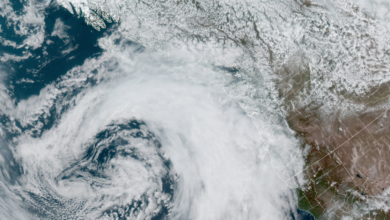Hyping Daily Maximum Temperature (Part 1)

Jennifer Marohasy
There are ways to ruin a perfectly good temperature history record. The Australian Bureau of Meteorology achieves this in several ways, primarily through industrial-scale remodeling (also known as homogenization – eliminating the natural warming and cooling cycles that correspond to periods of drought). and flooding), and also by deleting records for the hottest day in history, then there is now the establishment of limits on how cold temperatures can be recorded and also by replacing mercury thermometers with temperature probes are purpose-built, as far as I can tell, to record hotter temperatures for the same weather.
The Australian Bureau of Meteorology (BoM) regularly publishes new record hot days, and Australian scientist reports that heat records are now 12 times more likely than cold records. But how reliable – how verifiable – are the new records?
I have been trying for 5 years to verify the claim that September 23, 2017 in Mildura was the hottest September day ever recorded in Victoria. According to media reports at the time, it was the hottest September day since 1889 when records first began. Except that at the time, in September 1889, the maximum temperature was recorded at Mildura with a mercury thermometer. They are now recorded with a temperature probe that is more sensitive to temperature fluctuations and is therefore capable of recording warmer temperatures in the same weather.
In the absence of any other effects, a tool has a faster response time [temperature probe] will tend to record higher maximum and lower minimum temperatures than devices with slower response times [mercury thermometer]. This is most evident by the increase in the mean diurnal range. In most locations, especially in arid areas, it will also lead to a slight increase in mean temperatures, as short-term fluctuations in temperature are often greater during the day than at night.” Research Report No. 032by Blair Trewin, BoM, October 2018, page 21.
To standardize records from mercury thermometer temperature probes, one-second readings from the probe are usually averaged over one minute – or batches of ten seconds of readings averaged and then averaged again. in one minute. It is the worldwide standard to ensure records from temperature probes are comparable to those from mercury thermometers. But the Australian Bureau of Meteorology does Not do this, instead, they take one-second instantaneous readings and then input the highest of these one-second spot readings for any given 24-hour period as the maximum temperature multi-official for that date.
There is an easy way to test this.
Many Australians check’Observe the latest weather‘ for their local weather station online on the Bureau’s website, but few people realize that the values they see there represent the last one-second record in any half-hour period. which decision.
For example, on September 23, 2017, the highest value for that day as shown on Mildura’s observations page was 37.2 °C, recorded at 12:00 noon.
However, 37.7 °C was entered into the data archive as the official maximum temperature for September 23, 2017 in Mildura.
This represents a difference of 0.5°C.
This is used by the Bureau tallest one second reading is the maximum temperature for that day, while Final (Not peak or average) one-second reading in any 30-minute period displayed on the ‘Latest Weather Observations’ page.
Absolutely no average. Nothing is in stark contrast to international rules and standards.
This is puzzling, most unusual, and practically ridiculous.
Consider temperatures recorded at Sydney’s Observatory Hill automated weather station yesterday, as another example.
Australia is a drought- or flood-prone country so relatively hot years like 2017 tend to be followed by cooler years including the past three years. Until yesterday, 18 January 2023, Sydney had apparently experienced its longest days with temperatures below 30°C in 140 years. And I watched Chris Kenny on Sky TV last night mention this and show ‘Latest Weather Observations for Sydney – Observation Hill’ with temperature showing 30.1°C at 2:30pm.
I went online to the Bureau’s data archive to see the official maximum temperature record for this weather station on January 18, 2023. At 9 a.m. this morning, another value was obtained. input, value 30.2°C, error is 0.1.
There is a difference because the value on the ‘latest observations’ page is the last one-second read in that 30-minute period, while the value entered into the permanent archive is a high one-second read most of the day.
The World Meteorological Organization (WMO) provides a clear definition of the maximum daily temperature. This temperature can be read directly from a mercury thermometer, but when a temperature probe is used, ‘instant’ values must be averaged over one to ten minutes.
Back to Mildura and to recap, both the one-second value of 37.2 °C shown for 12:00 noon on September 23, 2017 and difference a one-second value of 37.7 °C recorded as the daily maximum temperature in Mildura on that same day does not comply with any international standards and is therefore not verifiable or standardized against the temperature. The temperature was officially recorded at Mildura with a mercury thermometer from January 1889 until November 1, 1996. It is therefore disrespectful to claim a new record hot day from 1889 for September 23. 2017, because the temperature on September 23, 2017 was measured with a different type of logger (temperature probe) and in a non-compliant manner (not averaged).
It is theoretically possible to know how the values of 37.2 °C and 37.7 °C compare with the mercury thermometers for that location at that time of year as Mildura is understood to be a parallel measurements. Those are the measurements from both the probe and the mercury thermometer in the same automatic weather station recorded on Form A8.
I have searched this information for 34 different locations as part of a Freedom of Information Request, which has so far been denied by the Bureau. An appeal against this is being heard at the Administrative Court of Appeal on 3 February 2023 in Brisbane.
The current probe, Mildura’s third probe, was installed on June 27, 2012. As I will show in a future blog post in this series, this probe has a very recording configuration. different from previous probes and mercury thermometers.
Theoretically, there is parallel data (temperature recorded from both probe and mercury) for Mildura between 1 January 1989 and 28 January 2015 and many of the A8 Forms scans were made available to me following the intervention of Minister Josh Frydenberg in November 2017. But So far, the Bureau has withheld Forms A8 related to the entirety of September 2012. This is the only September. There are parallel records with the same probe used to record the record hot day declared September 23, 2017 and a mercury thermometer.
Mildura has one of the longest temperature records for any place in the Murray Darling Basin. Official data for the region show that the number of warmer years has increased after temperature probes became the official record starting November 1, 1996.
******
Consider subscribing to my unusual electronic news updates by multiply here.



